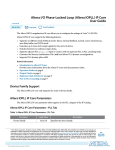Download Partial Reconfiguration IP Core User Guide
Transcript
Partial Reconfiguration IP Core 2015.05.04 UG-PARTRECON Send Feedback Subscribe Partial reconfiguration (PR) is fully supported in the Stratix® V device family, which offers you the ability to reconfigure part of the design's core logic such as LABs, MLABs, DSP, and RAM, while the remainder of the design continues running. The PR IP core can be implemented through the Qsys Interface, or via the Quartus II® IP Catalog. Partial reconfiguration is performed through either an internal host residing in the core logic or as an external host via dedicated PR pins. The advantage of the internal host is that you can store all the logic needed for PR on the device, without the need for external devices. Figure 1: PR IP core Components When you instantiate the PR IP core, the Main Controller module which includes the Control Block Interface Controller, Freeze/Unfreeze Controller, and the Data Source Controller are all instantiated. A Data Source Interface module provides you with a JTAG Debug Interface and PR Data Interface. If you choose to use the PR IP core as an internal host, it automatically instantiates the corresponding crcblock and prblock WYSIWYG atom primitives. CRCBLOCK PRBLOCK FPGA Control Block (CB) Interface Module CB Interface Controller Freeze/Unfreeze Controller Main Controller Module (1) Data Source Controller JTAG Debug Interface PR Data Interface PR Data Source Interface Module Note: 1. The main controller module handles all the handshaking signals of the CB interface and processes the incoming data, as needed, before sending to the PRBLOCK. It also handles the freeze/un-freeze PR interface. If it is used as external host (placed in another FPGA or CPLD), the PR IP core provides the crcblock and prblock WYSIWYG atom primitive as interface ports so that you can connect to the dedicated PR pins and CRC_ERROR pin on the target FPGA undergoing partial reconfiguration. © 2015 Altera Corporation. All rights reserved. ALTERA, ARRIA, CYCLONE, ENPIRION, MAX, MEGACORE, NIOS, QUARTUS and STRATIX words and logos are trademarks of Altera Corporation and registered in the U.S. Patent and Trademark Office and in other countries. All other words and logos identified as trademarks or service marks are the property of their respective holders as described at www.altera.com/common/legal.html. Altera warrants performance of its semiconductor products to current specifications in accordance with Altera's standard warranty, but reserves the right to make changes to any products and services at any time without notice. Altera assumes no responsibility or liability arising out of the application or use of any information, product, or service described herein except as expressly agreed to in writing by Altera. Altera customers are advised to obtain the latest version of device specifications before relying on any published information and before placing orders for products or services. www.altera.com 101 Innovation Drive, San Jose, CA 95134 ISO 9001:2008 Registered 2 UG-PARTRECON 2015.05.04 Instantiating the Partial Reconfiguration IP Core in the Qsys Interface Figure 2: Managing Partial Reconfiguration with an Internal or External Host The figure shows how these blocks should be connected to the PR control block (CB). In your system, you will have either the external host or the internal host, but not both. During PR, the PR Control Block (CB) is in Passive Parallel x16 programming mode. PR Bitstream file (.rbf) in external memory PR Bitstream file (.rbf) in external memory PR IP Core PR Region External Host PR Control Block (CB) PR Region Related Information • • • • • • FPGA Control Block Interface on page 15 Control Block Interface Controller on page 17 Freeze and Unfreeze Controls on page 18 Data Source Controller on page 18 Standard Partial Reconfiguration Data Interface on page 18 JTAG Debug Mode for Partial Reconfiguration on page 19 Instantiating the Partial Reconfiguration IP Core in the Qsys Interface Partial Reconfiguration(PR) is available as a Qsys component through the Qsys interface.You can choose to instantiate the core as an internal host or an external host. When instantiated with Qsys, PR is configured as a Conduit interface, or by enabling the Avalon Memory Map Slave interface. If you use Qsys and want PR included as component, you must instantiate the PR IP core in the Qsys interface. To instantiate the PR IP core with Qsys: 1. Click Tools > Qsys 2. In the Qsys interface IP Catalog expand Basic Functions > Configuration and Programming and select Partial Reconfiguration. 3. Configure your IP core variation using the settings appropriate to your design. Altera Corporation Partial Reconfiguration IP Core Send Feedback UG-PARTRECON 2015.05.04 Instantiating the Partial Reconfiguration IP Core in the Quartus II IP Catalog 3 Figure 3: Partial Reconfiguration IP Core in the Qsys Interface 4. Turn on Enable Avalon-MM slave interface to use the Avalon Memory Map Slave interface rather than the Conduit interface. 5. Click Finish. Related Information • Instantiating the Partial Reconfiguration IP Core in the Quartus II IP Catalog on page 3 • Partial Reconfiguration IP Core Parameters on page 6 • Creating a System With Qsys Instantiating the Partial Reconfiguration IP Core in the Quartus II IP Catalog Partial Reconfiguration(PR) is available from the IP Catalog.You can choose to instantiate the core as an internal host or an external host. If you are not using PR as a component of the Qsys interface, then you can instantiate PR with the Quartus II IP Catalog. The PR IP core can be instantiated as the internal host for Stratix V devices. When internal host is specified, both prblock and crcblock WYSIWYG atom primitives are auto-instantiated as part of the Partial Reconfiguration IP Core Send Feedback Altera Corporation 4 Instantiating the Partial Reconfiguration IP Core in the Quartus II IP Catalog UG-PARTRECON 2015.05.04 design. You can instantiate the PR IP core as the external host on any supported Altera devices as specified in the user selectable device family list. 1. Click Tools > IP Catalog. 2. Expand Installed IP > Library > Basic Functions > Configuration and Programming and select Partial Reconfiguration. 3. In the Save IP Variation dialog box, name your partial reconfiguration IP variation. Choose whether to use Verilog or VHDL. Click OK to save your variation. 4. Configure your IP core variation using the s appropriate to your design. Figure 4: Partial Reconfiguration IP Core in the IP Catalog 5. Turn on Enable Avalon-MM slave interface to use the Avalon Memory Map Slave interface rather than the Conduit interface. 6. Click Finish. The IP Catalog instantiates your IP core variation and displays a completion dialog box. Altera Corporation Partial Reconfiguration IP Core Send Feedback UG-PARTRECON 2015.05.04 Bitstream Compatibility Check 5 7. Click Exit. Related Information • Instantiating the Partial Reconfiguration IP Core in the Qsys Interface on page 2 • Partial Reconfiguration IP Core Parameters on page 6 Bitstream Compatibility Check Turn on the Enable bitstream compatibility check when instantiaing the PR IP core from either Qsys or the IP Catalog to have the Quartus II software verify the partial reconfiguration PR Bitstream file (.rbf). If an incompatible bitstream is detected, the PR operation aborts and the status output reports an error. Compatible PR Bitstream (.rbf) Static Region PR Bitstream Persona B from Same Design PR Region Persona A Incompatible PRPOF (Will Corrupt the design and May Damage Device) PR Bitstream Persona B from Different Design This prevents you from accidentally corrupting the static region of your design with a bitstream from an incompatible .rbf and risking damage to the chip being programmed. Partial Reconfiguration IP Core Send Feedback Altera Corporation 6 UG-PARTRECON 2015.05.04 Partial Reconfiguration IP Core Parameters When Enable bitstream compatibility check is turned on, the PR IP core creates a PR bitstream ID and displays it in the configuration dialog box. Related Information • Partial Reconfiguration IP Core Parameters on page 6 • Partial Reconfiguration IP Core Ports on page 8 Partial Reconfiguration IP Core Parameters IP Core Option Value Default Description On or Off On Turn on this option to use the PR IP core as an internal host. Both prblock and crcblock WYSIWYG atom primitives are auto-instantiated as part of your design. Disable this option to use the PR IP core as an external host. You must connect additional interface signals to the dedicated PR pins or the external prblock and crcblock WYSIWYG atom primitives interface signals if the PR IP core is used as an external host. Enable JTAG debug On or Off mode On Turn on this option to access the PR IP core with the Programmer to perform partial reconfigura‐ tion. Enable Avalon-MM On or Off slave interface Off Turn on this option to use the Avalon Memory Map slave interface Enable bitstream On or Off compatibility check Off Turn on this option to check the bitstream compatibility during PR operations for External Host. The bitstream compatibility check feature is always enabled for PR Internal Host. The PR bitstream ID value must be specified if this option is enabled for PR External Host. Use as PR Internal Host Altera Corporation Partial Reconfiguration IP Core Send Feedback UG-PARTRECON 2015.05.04 Partial Reconfiguration IP Core Parameters IP Core Option Value Default 7 Description PR bitstream ID -2147483648 to 2147483647 0 Specifies a signed 32-bit integer value of the PR bitstream ID for External Host. This value must match the PR bitstream ID generated during compilation for the target PR design. The PR bitstream ID value of the target PR design can be found in the Assembler compilation report (.asm.rpt). Input Data Width 1, 2, 4, 8, 16, or 32 16 Specifies the data width in bits. This option affects the data[] bus width. Target device familiy for partial reconfiguration "Arria V", "Arria V GZ", "Cyclone V", "Stratix V" "Stratix V" Select the target device family for partial reconfiguration when the PR megafunction is used as External Host. Note: This option is ignored for PR Internal Host. Clock-to-Data ratio 1, 2, or 4 1 Specifies the ratio between PR clock and PR data. Select '1' for plain PR data, '2' for encrypted PR data, or '4' for compressed PR data (with or without encryption) Divide error 1, 2, 4, 8, 16, 32, 64, detection frequency 128, or 256 by 1 Only available when the IP core is used as an Internal Host where the crcblock WYSIWYG atom primitive is auto-instantiated as part of the design. Specifies the divide value of the internal clock, which determines the frequency of the error detection CRC. The divide value must be a power of two. Refer to the device handbook to find the frequency of the internal clock for the selected device. Related Information • Using the Avalon Memory Mapped Slave Interface on page 13 • Avalon Memory Map Slave Interface Read and Write Transfer Timing on page 17 For more information on the timing specification for the Avalon Memory Mapped Slave interface. Partial Reconfiguration IP Core Send Feedback Altera Corporation 8 UG-PARTRECON 2015.05.04 Partial Reconfiguration IP Core Ports Partial Reconfiguration IP Core Ports I/O Port List for PR IP Core Table 1: Clock/Reset Ports These options are always available. Port Name Width Direction Function nreset 1 Input Asynchronous reset for the PR IP core. Set high to enable partial reconfiguration. Set low to prevent partial reconfiguration and reset the state machine in the PR IP core. clk 1 Input User input clock to the PR IP core. This signal is ignored during JTAG debug operations. Table 2: Conduit Interface This option is always available. Port Name freeze Altera Corporation Width 1 Direction Output Function Active high signal used to freeze the PR interface signals of the region undergoing partial reconfiguration. De-assertion of this signal indicates the end of PR operation. Partial Reconfiguration IP Core Send Feedback UG-PARTRECON 2015.05.04 Partial Reconfiguration IP Core Ports 9 Table 3: Conduit Interface These options are available when Enable Avalon-MM slave interface parameter is turned Off. Port Name pr_start Width 1 Direction Input Function A signal arriving at this port asserted high initiates a PR event. You must assert this signal high for a minimum of one clock cycle and de-assert it low prior to the end of the PR operation so that the PR IP core is ready to accept the next pr_start trigger event when the freeze signal is low. This signal is ignored during JTAG debug operations. data[] 1, 2, 4, 8, 16, or 32 Input Selectable input PR data bus width, either x1, x2, x4, x8, x16, or x32. Once a PR event is triggered, it is synchronous with the rising edge of the clk signal whenever the data_valid signal is high and the data_read signal is high. This signal is ignored during JTAG debug operations. data_valid 1 Input A signal arriving at this port asserted high indicates the data[] port contains valid data. This signal is ignored during JTAG debug operations. data_ready 1 Output A signal arriving at this port asserted high indicates the PR IP core is ready to read the valid data on the data[] port whenever the data_valid signal is asserted high. The data sender must stop sending valid data if this port is low. This signal deasserted low during JTAG debug operations. Partial Reconfiguration IP Core Send Feedback Altera Corporation 10 UG-PARTRECON 2015.05.04 Partial Reconfiguration IP Core Ports Port Name status[2..0] Width 3 Direction Output Function A 3-bit error output used to indicate the status of PR event. Once an error is detected (PR_ ERROR, CRC_ERROR, or Incompat‐ ible bitstream error), this signal is latched high and only get reset at the beginning of the next PR event, when pr_start is high and freeze is low. For example: 3’b000 – power-up or nreset asserted 3’b001 – PR_ERROR was triggered 3’b010 – CRC_ERROR was triggered 3’b011 – Incompatible bitstream error detected 3’b100 – PR operation in progress 3’b101 – PR operation passed 3'b110 – Reserved 3'b111 – Reserved Altera Corporation Partial Reconfiguration IP Core Send Feedback UG-PARTRECON 2015.05.04 Partial Reconfiguration IP Core Ports Port Name double_pr Width 1 Direction Input 11 Function When the pr_start signal is triggered until the de-assertion of freeze signal, a signal asserted high on this port indicates the PR event requires double PR cycle. A low signal on this port indicates a single PR cycle event. If your design requires the use of double PR because you have initialized RAM in the PR region, you must assert the double_pr input signal high so that the controller can handle double PR properly. You must assert this signal high if the PR bitstream (.rbf) is generated with the Write memory contents option turned on. Failure to do so causes a PR_ ERROR assertion during partial reconfiguration. This signal is ignored during JTAG debug operations. Table 4: Avalon-MM Slave Interface These options are available when Enable Avalon-MM Slave Interface parameter is turned On. Port Name avmm_slave_ address Width 1 Direction Input Function Avalon-MM address bus. The address bus is in the unit of Word addressing. Refer to the Qsys Component section for more details on the address mapping. This signal is ignored during JTAG debug operations. avmm_slave_read 1 Input Avalon-MM read control. This signal is ignored during JTAG debug operations. avmm_slave_ readdata Partial Reconfiguration IP Core Send Feedback 16 or 32 Output Avalon-MM read data bus. This signal is ignored during JTAG debug operations. Altera Corporation 12 UG-PARTRECON 2015.05.04 Partial Reconfiguration IP Core Ports Port Name avmm_slave_write Width 1 Direction Input Function Avalon-MM write control. This signal is ignored during JTAG debug operations. avmm_slave_ writedata avmm_slave_ waitrequest 16 or 32 Input Avalon-MM write data bus. This signal is ignored during JTAG debug operations. 1 Output Asserted to indicate that the IP is busy and it is unable to respond to a read or write request. This signal is pulled high during JTAG debug operations. Table 5: External Host Interface These options are available when Use as PR Internal Host parameter is turned Off. Port Name Width Direction Function crc_error_pin 1 Input Available when you use the PR IP core as an External Host. Connect this port to the dedicated CRC_ERROR pin of the FPGA undergoing partial reconfiguration, or connect directly to the crcblock WYSIWYG atom primitive. pr_ready_pin 1 Input Available when you use the IP core as an External Host. Connect this port to the dedicated PR_READY pin of the FPGA undergoing partial reconfiguration, or connect directly to the prblock WYSIWYG atom primitive. pr_error_pin 1 Input Available when the IP is used as the External Host. Connect this port to the dedicated PR_ERROR pin of the FPGA undergoing partial reconfiguration, or connect directly to the prblock WYSIWYG atom primitive. Altera Corporation Partial Reconfiguration IP Core Send Feedback UG-PARTRECON 2015.05.04 Using the Avalon Memory Mapped Slave Interface Port Name Width Direction 13 Function pr_done_pin 1 Input Available when the PR IP core is used as the External Host. Connect this port to the dedicated PR_DONE pin of the FPGA undergoing partial reconfiguration, or connect directly to the prblock WYSIWYG atom primitive. pr_request_pin 1 Output Available when the IP is used as the External Host. Connect this port to the dedicated PR_ REQUEST pin of the FPGA undergoing partial reconfigura‐ tion, or connect directly to the prblock WYSIWYG atom primitive. pr_clk_pin 1 Output Available when the IP is used as the External Host. Connect this port to the dedicated DCLK of the FPGA undergoing partial reconfiguration, or connect directly to the prblock WYSIWYG atom primitive. 16 Output Available when the IP is used as the External Host. Connect this port to the dedicated DATA[15..0] pins of the FPGA undergoing partial reconfigura‐ tion, or connect directly to the prblock WYSIWYG atom primitive. pr_data_ pin[15..0] Related Information Avalon Memory Map Slave Interface Data/CSR Memory Map on page 14 Using the Avalon Memory Mapped Slave Interface Perform partial reconfiguration through the Avalon Memory Mapped Slave interface by following these steps: Partial Reconfiguration IP Core Send Feedback Altera Corporation 14 UG-PARTRECON 2015.05.04 Avalon Memory Map Slave Interface Data/CSR Memory Map 1. Avalon Memory Mapped Master component writes 16’h0001 (or 16’h0003 if the design requires double PR) to this IP address offset 0x1 to trigger PR operation. 2. Avalon Memory Mapped Master component writes PR bitstream (data width in x16) to this IP address offset 0x0 until all the PR bitstream is written. 3. Avalon Memory Mapped Master component reads the data from this IP address offset 0x1 to check the status[2:0] value. Optionally, Avalon-MM Master component can read the status[2:0] of this IP during PR operation to understand if any early failure was detected, for example, PR_ERROR. Related Information • Partial Reconfiguration IP Core Parameters on page 6 • Avalon Memory Map Slave Interface Read and Write Transfer Timing on page 17 For more information on the timing specification for the Avalon Memory Mapped Slave interface. Avalon Memory Map Slave Interface Data/CSR Memory Map Table 6: Data/CSR Memory Map Format Name PR_DATA Address Offset 0x0 Width 16 or 32 (1) Access Write Description Every data write to this address indicates this bitstream was sent to the IP core. Performing a read on this address returns all 0's. PR_CSR (1) 0x1 16 or 32(1) Read/Write Controls and status registers. Depending on the Avalon Memory Mapped data bus width. Altera Corporation Partial Reconfiguration IP Core Send Feedback UG-PARTRECON 2015.05.04 FPGA Control Block Interface 15 Table 7: PR_CSR Control and Status Registers Bit Offset 0 Description Read and write control register for pr_start signal. Refer to “Input/output Port List” section for more details on pr_start signal. pr_start = PR_CSR[0] PR_CSR[0] is de-asserted to value “0” by the IP core automatically one clock cycle after it is asserted to streamline the flow so you do not need to manually assert and de-assert this register to control pr_ start signal. 1 Read and write control register for double_pr signal. double_pr = PR_CSR[1] 2-4 Read only status register for status[2:0] signal. PR_CSR[4:2] = status[2:0] 5-15 or 5-31(1) Reserved Related Information • Avalon Memory Map Slave Interface Read and Write Transfer Timing on page 17 • Partial Reconfiguration IP Core Ports on page 8 FPGA Control Block Interface When you instantiate the PR IP core, you can choose to use it as either an internal host or external host. If it is used as an internal host, the PR IP core auto instantiates the corresponding device crcblock and prblock WYSIWYG atom primitive. If PR is used as external host (placed in another FPGA or CPLD), the PR IP core provides the crcblock and prblock interface ports so you can connect the host to the dedicated PR pins and CRC_ERROR pin on the target FPGA being partially reconfigured. Note: You may need to instantiate the PR IP core as an external host to share the crcblock and prblock interface even though the PR IP core is located inside the FPGA being partially reconfigured. For example; your design uses another piece of IP, which instantiates its own crcblock WYSIWYG atom primitive to unload the Error Message Register (EMR) whenever CRC_ERROR is detected. Your design must share the crcblock interface signals between the PR IP core and secondary IP, otherwise the Quartus II compilation will fail because more than one crcblock is not allowed. You can also instantiate the PR IP core as the external host so be able to add crcblock and problock WYSIWYG atom primitive instances to SignalTap II for debugging purposes. Partial Reconfiguration IP Core Send Feedback Altera Corporation 16 UG-PARTRECON 2015.05.04 Partial Reconfiguration IP Core Timing Specification Partial Reconfiguration IP Core Timing Specification This timing diagram illustrates a successful Partial Reconfiguration IP core operation. Pass or fail can be determined with the status[2:0] output signal. The PR operation is initated when you assert the pr_start signal. You can monitor the status[] or freeze signals to detect the end of the PR operation. Figure 5: Partial Reconfiguration Timing clk (1) pr_start freeze double_pr (2) (3) status[2:0] D1 (First Data) data[] (6) data_ready D3 D4 D5 Dummy Data D6 (Last Data) (5) (4) data_valid D2 (7) Note: 1. You must assert pr_start signal high for a minimum of one clock cycle to initiate PR and deassert pr_start before sending the last data. 2. status[] signal is reset when pr_start is asserted and changes during a PR operation if any error such as a CRC_ERROR, PR_ERROR, or bitstream incompatibility error is detected. 3. status[] signal changes after a PR operation if CRC_ERROR is detected and no error happens during the previous PR operation. 4. The data_valid signal is not required to be asserted at the same time as the pr_start. You can provied the data[] and assert data_valid when appropriate. 5. You can either drive the data_valid signal low after sending the last data, or contiue to assert data_valid high with dummy data on data[] until the end of PR, when freeze is driven low or status[] is updated/ 6. data[] is transferred only when data_valid and data_ready are asserted on the same cycle. Do not drive new data on the data bus, when both data_valid and data_ready have not been asserted high. 7. The data_ready signal is driven low once the PR IP Core receives the last data. The data[], data_valid, and data_ready signals comply with the Avalon-ST specification for Data Transfer with Backpressure. The PR IP Core acts as a sink, with readLatency = 0. For more information, refer to the Avalon Interface Specifications. If your CDRATIO is not 1, or your data[] width is x32 for series-V devices, the data_ready alternates between high and low for one or more clock cycles. The PR IP Core requires additional clock cycles to process the data recieved. You should hold data[] when data_ready is low. Important: The PR_CLK signal has a different nominal maximum frequency for each device. Most Stratix V devices have a nominal maximum frequency of at least 62.5 MHz. Altera Corporation Partial Reconfiguration IP Core Send Feedback UG-PARTRECON 2015.05.04 Avalon Memory Map Slave Interface Read and Write Transfer Timing 17 Related Information link/nik1412467993397/nik1412467975241 Avalon Interface Specifications for data transfer with backpressure Avalon Memory Map Slave Interface Read and Write Transfer Timing The Avalon-MM interface supports read and write transfers with a slave-controlled waitrequest. The slave can stall the interconnect for as many cycles as required by asserting the waitrequest signal. If a slave uses waitrequest for either read or write transfers, it must use waitrequest for both. A slave typically receives address, read or write, and writedata after the rising edge of the clock. A slave asserts waitrequest before the rising clock edge to hold off transfers. When the slave asserts waitrequest, the transfer is delayed. And, the address and control signals are held constant. Transfers complete on the rising edge of the first clk after the slave port deasserts waitrequest. Figure 6: Read and Write Transfers for Avalon-MM Slave Interface 1 2 3 4 5 6 clk address address read write waitrequest readdata readdata writedata writedata The numbers in this timing diagram, mark the following transitions: 1. address and read are asserted after the rising edge of clk. waitrequest is asserted stalling the transfer. 2. waitrequest is sampled. Because waitrequest is asserted, the cycle becomes a wait-state. address, read, and write remain constant. 3. The slave presents valid readdata and deasserts waitrequest. 4. readdata and deasserted waitrequest are sampled, completing the transfer. 5. address, writedata, and write signals are asserted. The slave responds by asserting waitrequest stalling the transfer. 6. The slave captures writedata and deasserts waitrequest ending the transfer. Related Information Avalon Memory Mapped Interfaces For more information on read and write transfers with Avalon Memory Mapped Interfaces Control Block Interface Controller This controller handles all the handshaking signals of the prblock WYSIWYG atom primitive and it will monitor CRC_ERROR signals of crcblock WYSIWYG atom primitives throughout the PR event (before, during, and after PR) to detect any CRAM error. Partial Reconfiguration IP Core Send Feedback Altera Corporation 18 UG-PARTRECON 2015.05.04 Freeze and Unfreeze Controls The controller receives data and sends it to the prblock WYSIWYG atom primitive during a PR event with the clock-to-data ratio (CDRATIO) you specify when you instantiate the Partial Reconfiguration IP core. Table 8: CDRATIO for PR Compression and/or Encryption The following table lists the range of values for the clock-to-data ratio for bitstreams that are compressed, encrypted, both, or neither. Compressed Encrypted Clock-to-Data Ratio No No x1 No Yes x2 Yes No x4 Yes Yes x4 Related Information Instantiating the Partial Reconfiguration IP Core in the Quartus II IP Catalog on page 3 Freeze and Unfreeze Controls The Freeze/Unfreeze controller logic of the Partial Reconfiguration IP core provides a signal to the user specified PR regions, freezing all input signals during PR operation to avoid current contention. You begin a PR event by asserting the pr_start input port to the PR IP core. The Freeze/Unfreeeze Controller then asserts the output freeze signal high and sends it to the PR region you specified. All the input signals coming into that PR region are then pulled high, preventing current contention in the device. The PR IP core does not differentiate between multiple PR regions, so you may need to create custom freeze logic if you are freezing individual PR regions. Once the PR operation is completed, this controller asserts the output freeze signal low. All the input signals coming into the specified PR region are released and the PR region is ready for normal operation. Related Information • Partial Reconfiguration IP Core Timing Specification on page 16 • Partial Reconfiguration IP Core Ports on page 8 Data Source Controller This controller handles the source of PR data, either from JTAG or standard data interface. The JTAG interface takes precedence over the standard PR data interface. For example, whenever JTAG is engaged through command from Quartus II Programmer tool, the PR data is sourced from the JTAG interface rather than the PR data interface. Standard Partial Reconfiguration Data Interface Altera Corporation Partial Reconfiguration IP Core Send Feedback UG-PARTRECON 2015.05.04 JTAG Debug Mode for Partial Reconfiguration 19 The PR data interface provides you with selectable input data width; x1, x2, x4, x8, x16, and x32. It can be connected to ASMI_PARALLEL as well as the Avalon interface to obtain PR data from on-chip RAM, external flash device, or PR over PCIe. If the input data width is other than x16, the PR IP core includes a data upsize or downsize module so that the data output to the Data Source Controller is always x16. JTAG Debug Mode for Partial Reconfiguration The JTAG debug mode allows you to configure partial reconfiguration bitstream through the JTAG interface. Use this feature to debug PR bitstream and eventually helping you in your PR design prototyping. This feature is available for internal and external host. During JTAG debug operation, the JTAG command sent from the Quartus II Programmer ignores and overrides most of the Partial Reconfiguration IP core interface signals (clk, pr_start, double_pr, data[], data_valid, and data_read). Note: The TCK is the main clock source for PR IP core during this operation. You can view the status of Partial Reconfiguration operation in the messages box and the Progress bar in the Quartus II Programmer. The PR_DONE, PR_ERROR, and CRC_ERROR signals will be monitored during PR operation and reported in the Messages box at the end of the operation. The Quartus II Programmer can detect the number of PR_DONE instruction(s) in plain or compressed PR bitstream and, therefore, can handle single or double PR cycle accordingly. However, only single PR cycle is supported for encrypted Partial Reconfiguration bitstream in JTAG debug mode (provided that the specified device is configured with the encrypted base bitstream which contains the PR IP core in the design). Note: Configuring an incompatible PR bitstream to the specified device may corrupt your design, including the routing path and the PR IP core placed in the static region. When this issue occurs, the PR IP core stays in an undefined state, and the Quartus II Programmer is unable to reset the IP core. As a result, the Quartus II Programmer generates the following error when you try to configure a new PR bitstream: Error (12897): Partial Reconfiguration status: Can't reset the PR megafunction. This issue occurred because the design was corrupted by an incompatible PR bitstream in the previous PR operation. You must reconfigure the device with a good design. Configuring Partial Reconfiguration Bitstream in JTAG Debug Mode To configure the Partial Reconfiguration bitstream in JTAG debug mode, follow these steps: 1. In the Quartus II Programmer GUI, right click on a highlighted base bitstream (in .sof) and then click Add PR Programming File to add the PR bitstream (.rbf). Partial Reconfiguration IP Core Send Feedback Altera Corporation 20 Configuring Partial Reconfiguration Bitstream in JTAG Debug Mode UG-PARTRECON 2015.05.04 Figure 7: Adding PR Programming File 2. After adding thePR bitstream, you can change or delete the Partial Reconfiguration programming file by clicking Change PR Programming File or Delete PR Programming File. Altera Corporation Partial Reconfiguration IP Core Send Feedback UG-PARTRECON 2015.05.04 Configuring Partial Reconfiguration Bitstream in JTAG Debug Mode 21 Figure 8: Change PR Programming File or Delete PR Programming File 3. Click Start to configure the PR bitstream. The Quartus II Programmer generates an error message if the specified device does not contain the PR IP core in the design (you must instantiate the Partial Reconfiguration IP core in your design to use the JTAG debug mode). Partial Reconfiguration IP Core Send Feedback Altera Corporation 22 UG-PARTRECON 2015.05.04 Configuring Partial Reconfiguration Bitstream in JTAG Debug Mode Figure 9: Starting PR Bitstream Configuration 4. Configure the valid .rbf in JTAG debug mode with the Quartus II Programmer. Altera Corporation Partial Reconfiguration IP Core Send Feedback UG-PARTRECON 2015.05.04 Configuring Partial Reconfiguration Bitstream in JTAG Debug Mode 23 Figure 10: Configuring Valid .rbf 5. The JTAG debug mode is also supported if the PR IP core is pre-programmed on the specified device. Partial Reconfiguration IP Core Send Feedback Altera Corporation 24 Configuring Partial Reconfiguration Bitstream in JTAG Debug Mode UG-PARTRECON 2015.05.04 Figure 11: Partial Reconfiguration IP Core Successfully Pre-programmed 6. The Quartus II Programmer reports error when you try to configure the corrupted .rbf in JTAG debug mode. Altera Corporation Partial Reconfiguration IP Core Send Feedback UG-PARTRECON 2015.05.04 Sample Freeze Wrapper for Multiple PR Regions 25 Figure 12: Configuring Corrupted .rbf Sample Freeze Wrapper for Multiple PR Regions The following Verilog HDL pseudocode shows an example of how to create a simple freeze wrapper for two PR regions. The same method can be applied to any number of PR regions. // pseudocode for a simple freeze wrapper for two PR regions module design_top (…); // user selects region A or B to be PR’ed input pr_region_A_or_B; input pr_start; assign freeze_A_w = pr_region_A_or_B ? pr_freeze_w : 1’b0; assign freeze_B_w = pr_region_A_or_B ? 1’b0 : pr_freeze_w; // freeze output of PR IP core alt_pr_sv my_alt_pr ( .freeze (pr_freeze_w), // always stays low until user asserts pr_start .pr_start (pr_start), … ); // Freeze wrapper for input signals of single PR region A // Follow existing recommendations in the PR user guide for the details freeze_region_A Partial Reconfiguration IP Core Send Feedback Altera Corporation 26 UG-PARTRECON 2015.05.04 Sample PR IP Core as an External Host on the Same Device my_freeze_region_A ( .freeze(freeze_A_w), … ); // Freeze wrapper for input signals of single PR region B // Follow existing recommendations in the PR user guide for the details freeze_region_B my_freeze_region _B ( .freeze(freeze_B_w), … ); endmodule Related Information Design Planning for Partial Reconfiguration For more information on creating a freeze wrapper for partial reconfiguration. Sample PR IP Core as an External Host on the Same Device There are occasions where you should instantiate the PR IP core as external host on the same device. 1. To monitor the prblock and crcblock WYSIWYG interface signals using the SignalTap II tool or to probe these signals by routing them to any GPIO. 2. To share the prblock and crcblock WYSIWYG interface signals with another IP. For example, using the Fault Injection IP or a user controller to unload the Error Message Register (EMR) when a CRC_ERROR is asserted. The following Verilog HDL pseudocode shows an example of how to instantiate the PR IP core as external host on the same device. // pseudocode for instantiating the PR IP core as ExternalHost // on the same device module design_top (…); // PR IP core instantiated as External Host alt_pr_sv my_alt_pr ( .pr_request_pin (pr_request_w), .pr_ready_pin (pr_ready_w), .pr_done_pin (pr_done_w), .pr_error_pin (pr_error_w), .pr_clk_pin (pr_clk_w), .pr_data_pin (pr_data_w), .crc_error_pin (crc_error_w), ... ); // Stratix V prblock WYSIWYG stratixv_prblock my_prblock ( .clk (pr_clk_w), .corectl(1'b1), // note that this design still PR from core .prrequest (pr_request_w), .data (pr_data_w), .error (pr_error_w), .ready (pr_ready_w), .done (pr_done_w) ); // Stratix V crcblock WYSIWYG stratixv_crcblock my_crcblock ( .crcerror(crc_error_w), … ); endmodule Altera Corporation Partial Reconfiguration IP Core Send Feedback UG-PARTRECON 2015.05.04 Revision History 27 Related Information Design Planning for Partial Reconfiguration For more information on instantiating the an external host for partial reconfiguration. Revision History Date May 2015 Version 2015.05.04 Changes Revised the following topics: • Partial Reconfiguration IP Core Parameters—added new parameters for device family support • Partial Reconfiguration IP Core Ports—added new port options • Partial Reconfiguration IP Core Timing Specification —revised the timing diagram January 2015 2015.01.29 Minor error corrections. August 2014 2014.08.20 • Added Avalon Memory Map slave interface • Updated Ports and Parameters to support Avalon Memory Map slave interface • Added Bitstream compatibility checking • Added sample pseudo-code for creating a freeze wrapper for multiple PR regions and creating an external host on the same device. November 2013 2013.11.04 Initial release Partial Reconfiguration IP Core Send Feedback Altera Corporation






































